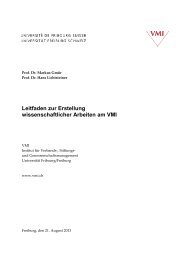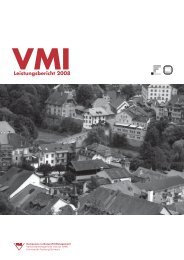Government Policy and the Nonprofit Sector: Switzerland - VMI
Government Policy and the Nonprofit Sector: Switzerland - VMI
Government Policy and the Nonprofit Sector: Switzerland - VMI
- TAGS
- nonprofit
- switzerland
- vmi.ch
Create successful ePaper yourself
Turn your PDF publications into a flip-book with our unique Google optimized e-Paper software.
Nollert <strong>and</strong> Budowski <strong>Government</strong> <strong>Policy</strong> <strong>and</strong> <strong>the</strong> <strong>Nonprofit</strong> <strong>Sector</strong>: Switzerl<strong>and</strong><br />
1. Shifts in Philosophy<br />
As stated in <strong>the</strong> introduction, liberal attitudes are at <strong>the</strong> core of <strong>the</strong> Swiss constitution, <strong>and</strong> <strong>the</strong>refore <strong>the</strong> Swiss<br />
government attributes a major role to NPOs in terms of policy formulation <strong>and</strong> implementation, as well as in<br />
regulating economic processes <strong>and</strong> tackling social problems. Since <strong>the</strong> late 1990s, however, <strong>the</strong> partnership<br />
between <strong>the</strong> state <strong>and</strong> NPOs has been challenged by <strong>the</strong> economic climate. One challenge comes from <strong>the</strong><br />
neoliberal economists, who argue that extensive market regulation in combination with raised levels of<br />
participation options for associations have resulted in “distribution coalitions” that were responsible for <strong>the</strong> lack<br />
of innovation in <strong>the</strong> post‐war period (Borner, Brunetti <strong>and</strong> Straubhaar 1990).<br />
Ano<strong>the</strong>r challenge has come from <strong>the</strong> philosophy of New Public Management, which calls for a more efficient<br />
public‐private partnership. At <strong>the</strong> same time <strong>the</strong> partnership is challenged by questions as to whe<strong>the</strong>r subsidies<br />
for NPOs in <strong>the</strong> social sector <strong>and</strong> sector of development cooperation are necessary. Although radical<br />
suggestions, such as abolishing plebiscitary devices (initiatives or referendums, <strong>the</strong> Federation Complaint Right),<br />
or canceling subsidies for well‐known welfare <strong>and</strong> relief organizations are not acceptable to <strong>the</strong> majority, <strong>the</strong>y<br />
point to an increasingly skeptical judgment promoted primarily by <strong>the</strong> Swiss People’s Party of <strong>the</strong> social <strong>and</strong><br />
economic functionality of associations <strong>and</strong> environmental organizations.<br />
2. Changes in Level <strong>and</strong> Type of Support<br />
Over <strong>the</strong> past few years, <strong>the</strong> government’s position has changed in two respects: (i) state institutions are acting<br />
with increased caution when meting out financial support; (ii) NPOs are receiving greater regulatory support.<br />
Since Switzerl<strong>and</strong> is federally organized it is important to stress that taxation in particular, can vary widely at <strong>the</strong><br />
federal, cantonal, <strong>and</strong> municipal levels. The impact of this is that <strong>the</strong> Federal government, <strong>the</strong> cantons, <strong>and</strong><br />
municipalities raise taxes in independent ways <strong>and</strong> <strong>the</strong>reby all have a certain amount of control over specific<br />
devices acknowledging or supporting <strong>the</strong> work of NPOs by means of tax deductions or acknowledgement of<br />
<strong>the</strong>ir contributions to society.<br />
In 2006 <strong>the</strong> Foundation <strong>and</strong> Fiscal Law for <strong>Nonprofit</strong> Organizations 28 in <strong>the</strong> Civil Code was revised <strong>and</strong> ensured<br />
that differences between cantons <strong>and</strong> municipalities were minimized in <strong>the</strong> medium‐term, <strong>and</strong> allowable<br />
deductions for donations from direct Federal taxes was increased from 10 percent to 20 percent as of January<br />
2006. The point of departure for this revision dates back to a parliamentary initiative. It assumed that revising<br />
<strong>the</strong> Foundations legislation would increase <strong>the</strong> propensity to provide nonprofit foundations with greater<br />
financial means.<br />
At <strong>the</strong> cantonal level <strong>the</strong> deductions have been continually revised, which increased <strong>and</strong> harmonized <strong>the</strong> overall<br />
level of tax deduction for natural persons. As of January 1, 2006 <strong>and</strong> January 1, 2007 respectively, twelve<br />
cantons increased <strong>the</strong>ir tax deductions in respect to donations to welfare <strong>and</strong> relief organizations to 20 percent<br />
(Solothurn, Obwalden, Appenzell Innerrhoden, Glarus, Nidwalden, St. Gallen, Schwyz, Uri, Vaud, Zug, <strong>and</strong><br />
Luzern). Tax deductions of this sort have already been at this level for many years in three additional cantons<br />
(Aargau, Schaffhausen, <strong>and</strong> Zurich). The front‐runner is Basel‐L<strong>and</strong> with a 100 percent tax deduction in respect<br />
28 Stiftungs‐ und steuerliches Gemeinnützigkeitsrecht<br />
9











